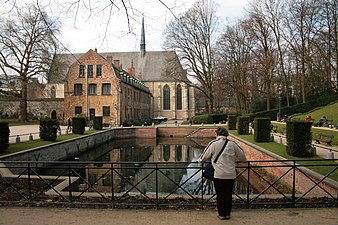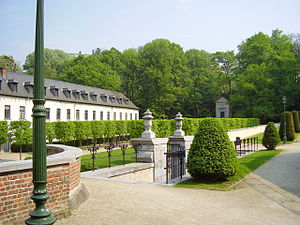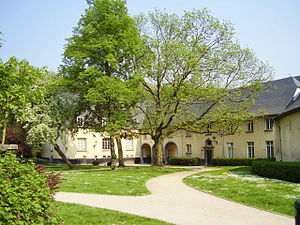La Cambre Abbey
This article needs additional citations for verification. (November 2019) |
| La Cambre Abbey | |
|---|---|
 View from the cour d'honneur (main courtyard) | |
 | |
| General information | |
| Type | Abbey |
| Architectural style | |
| Town or city | Ixelles, Brussels-Capital Region |
| Country | Belgium |
| Coordinates | 50°49′08″N 4°22′27″E / 50.81889°N 4.37417°ECoordinates: 50°49′08″N 4°22′27″E / 50.81889°N 4.37417°E |
| Construction started | 1201 |
| Construction stopped | Deconsecrated in 1796 |
| Designations | Protected[1] |
| Website | |
| Official website | |
La Cambre Abbey (French: Abbaye de La Cambre) or Ter Kameren Abbey (Dutch: Abdij Ter Kameren) is a former Cistercian abbey in Ixelles, Brussels (Belgium). It is located in the Maelbeek valley between the Bois de la Cambre/Ter Kamerenbos and the Ixelles Ponds. The abbey church is a Catholic parish of the Archdiocese of Mechelen-Brussels and home to a community of Norbertine canons, while other parts of the monastery house the headquarters of the Belgian National Geographic Institute and La Cambre, a prestigious visual arts school.
The abbey was founded around 1196. It was suppressed during the French Revolution. Most of today's buildings date from the 18th century; only the church, the refectory and the wing of the capitular hall maintain their medieval character. The simple abbey church houses Albert Bouts' early 16th-century oil painting The Mocking of Christ.
History[]
Early history[]
The abbey was founded around 1196 by its , with the support of the monastic community of Villers Abbey (in present-day Walloon Brabant), following the Cistercian rule. Henry I, Duke of Brabant, donated the Ixelles Ponds, a water mill, and the domain of the monastery. The Abbaye de la Chambre de Notre-Dame ("Abbey of the Chamber of Our Lady"), hence La Cambre in short form, remained under the spiritual guidance of Villers, one of the most important Cistercian communities.

Saint Boniface of Brussels (1182–1260), a native of Ixelles, canon of Saint Gudula (future cathedral of Brussels), who taught theology at the University of Paris and was made bishop of Lausanne (Switzerland) in 1231, lived for eighteen years in the abbey and is interred in the church. The mystic leper Saint Alix lived in the community at the same epoch.
During the numerous wars of religion of the 16th and 17th centuries, the abbey was largely destroyed, but it was rebuilt in the 18th century in the French form it largely retains. It was suppressed during the French Revolution and sold as national property in 1796.
20th century–present[]
After the abbey closed as a monastic community, the buildings were used successively as a military hospital, a cotton manufacture, a poor house, and a military school. During the First World War, the premises were occupied by German troops. In 1921, the League of Friends of La Cambre moved into the abbey to preserve it. The terraced garden and formal clipped bosquets were restored in the 18th-century manner starting in 1924.
La Cambre Abbey has been designated a historic site since 30 June 1953.[2]
Architecture and landscape[]
On the Ixelles Ponds' side, La Cambre Abbey has two entrances. The cloister adjoins the Church of Our Lady of the Cambre and the refectory. The abbey church shows the transition between the primitive Gothic and the Flamboyant Gothic styles. Its northern part dates from the 15th century, whilst its southern part has retained its original roof and two windows from the early 14th century. It includes a single nave 54 m (177 ft) long and 11 m (36 ft) wide, covered with a shingle vault erected in 1603.
The 18th-century abbesses' residence, with its cour d'honneur (main courtyard) in the neoclassical style and French formal gardens, has preserved the presbytery, the stables, and other dependencies.
The abbey church (14th–16th centuries) In the public garden, there is a small pond with one of the sources of the Maelbeek. Clipped trees in a formal bosquet form the Promenade des abbesses View of the gardens Another view of the gardens St. Boniface's Chapel
Residents[]
Commendatory Abbesses[]
- Régine, Lady of Beauffort
- Marie, Lady of Egmont
- Catherine de t'Serclaes
- Marie, Countess vander Noot
- 1627–1709: , elected on 6 March 1683, daughter of Anthonie II Schetz, Count of Grobbendonk
- 1757–1794: , last abbess, named Dame Séraphine
Bernardine Nuns[]
Most of the residing nuns were daughters of important Noble Houses and the abbesses were usually members of wealthy families. The sisters were named Bernardines of La Cambre.
- Saint Alice of Schaerbeek (1204–1250)
- Constantia Rubens, daughter of Peter Paul Rubens
- Catherine d'Ittre

References[]
- ^ http://patrimoine.brussels/liens/registre/registre-du-patrimoine-protege-en-region-de-bruxelles-capitale-catalogue-illustre
- ^ "Ixelles - Abbaye de la Cambre". www.irismonument.be. Retrieved 19 August 2019.
- Christian monasteries in Brussels
- Ixelles
- Protected heritage sites in Brussels
- Christian monasteries established in the 12th century
- Cistercian monasteries in Belgium
- Monasteries destroyed during the French Revolution







